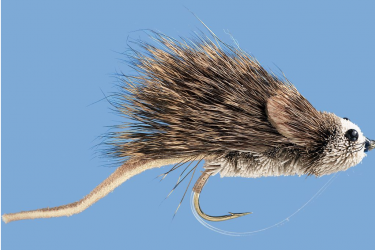So much of fly fishing for trout focuses on using tiny flies that resemble aquatic insects. However, sometimes it pays to go big when fly fishing for trout, especially when you want to catch big trout.
One of the most effective big flies for trout is the mouse pattern. Large and noisy, a mouse pattern catches a trout’s attention and can often entice big trout, who are reluctant to chase the typical offerings, into hitting your bait.
If you want to catch big trout, here are some mouse pattern tips that will help you use this fly effectively.
Retrieve
Mouse patterns are big flies, so they will easily catch a trout’s attention. The key to fishing a mouse fly is to not get the wrong type of attention.
Think about the way a mouse swims in the water. It steadily chugs across the surface. That is the same motion you want to achieve with your fly. Cast your mouse fly upstream and across, just as you would with other dry flies. Gather in the slack; then begin retrieving with a natural motion. The best way to do this is to move the rod tip back and forth in a wiggling motion as you slowly retrieve the line.
One strategy you want to avoid is make unnatural movements with your mouse fly. Stripping your line in quickly or making big splashes with your mouse fly will likely scare trout. Keep your movements slow, steady and natural. The right retrieve creates vibrations in the water that trout will identify as prey.
Location
When looking for the best locations to fish your mouse fly, think about where a mouse is most likely to be found in a trout stream. More times than not, a mouse is in the water, because it fell in the water by accident. This, of course, is likely to be along the bank. And once the mouse is in the water, it will want to get back to shore as quickly as possible.
Fish your mouse pattern along the edges of the stream, especially in areas with overhanging trees, deadfalls, or high grass that bends out over the water. These are also likely holding areas for big trout.
Low light
The best time to fish with a mouse pattern is during the low-light hours. If night fishing for trout is available in your area, this is an especially good time. If not, go early in the morning or near sunset. These are prime feeding times for big trout.
The hit
When going after a big fly like a mouse imitation, it is not uncommon for trout to take a few runs at it before actually hitting it. Before you try setting the hook, make sure the trout has actually taken the fly. Do not set the hook on the first sight of the fish going after the bait.








